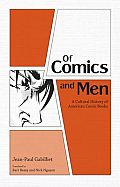Video Killed the Comic-Book Star
From Jean-Paul Gabillet, Of Comics and Men: A Cultural History of American Comic Books, translated by Bart Beaty and Nick Nguyen:
![]() All of Gabillet’s citations for this passage go through one essay also cited in many other studies of comic books: Patrick Parsons’s “Batman and His Audience: The Dialectic of Culture,” published in The Many Lives of the Batman. I’ve looked for that book for a while. It came out from a British academic press in 1991, before the study of comics was wide or respected in American culture, and there’s no copy in my local library network. I must make a note to visit a local university.
All of Gabillet’s citations for this passage go through one essay also cited in many other studies of comic books: Patrick Parsons’s “Batman and His Audience: The Dialectic of Culture,” published in The Many Lives of the Batman. I’ve looked for that book for a while. It came out from a British academic press in 1991, before the study of comics was wide or respected in American culture, and there’s no copy in my local library network. I must make a note to visit a local university.
The Gabillet book is more comprehensible than Thierry von Groensteen’s The System of Comics, translated by the same team for the same university press. Still, there are some maddening passages, such as:
In 1960, 41 percent of boys in the fourth grade in San Francisco read at least nine comics a month; by comparison, ten years earlier, a study based on a sampling of over fourteen hundred young students in Des Moines, Iowa, showed that 75 percent of children of the same age read similar quantities.I was happy to see studies to support one of my hunches. In particular, the fall of romance comics from market-driving leaders in the late 1940s to a small slice of a shrinking market a decade later strikes me as due to how readers found similar storytelling at greater value on television soap operas. Superhero and science-fiction comics offered stories and visuals that television production couldn’t match, so they kept their audiences relatively well. Now, of course, they’re losing out, too.
A 1961 study had also examined the differences between two Canadian cities, one with television, one without, respectively referred to as Teletown and Radiotown (at the start of the 1960s it was no longer possible to find an American city without television): a third of the sixth-grade students read more than ten comics a month in Teletown as opposed to 87 percent in Radiotown; for high school students, the gap was 6 percent at Teletown versus 49 percent in Radiotown.
Clearly, television consumption among children seemed to be inversely proportional to comic book reading.
The Gabillet book is more comprehensible than Thierry von Groensteen’s The System of Comics, translated by the same team for the same university press. Still, there are some maddening passages, such as:
Nineteen fifty-two was the year where the combined printings of comic books reached their historical maximum but there is no data at our disposal that allow us to quantitatively determine this.If there’s no data to “quantitatively determine” how many comic books were printed in a year, how can we identify a “historical maximum”? Apparently that statement is (a) a relative measurement, based on (b) qualitative impressions by individuals at the time. But one cited witness’s estimate of production in 1952 is twice as much as another’s.



No comments:
Post a Comment